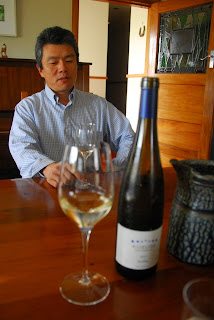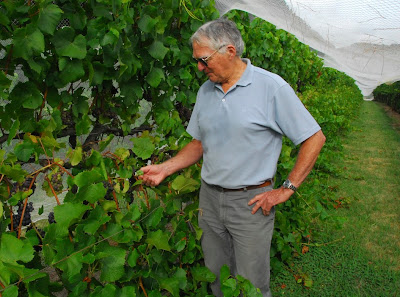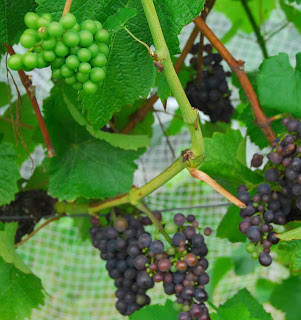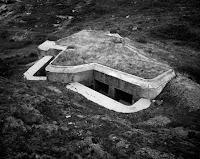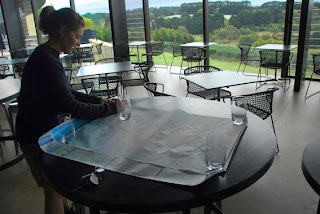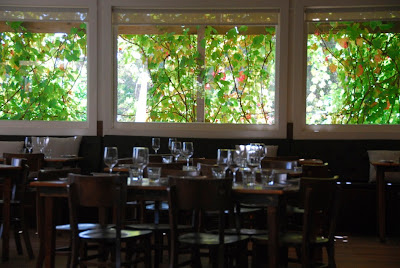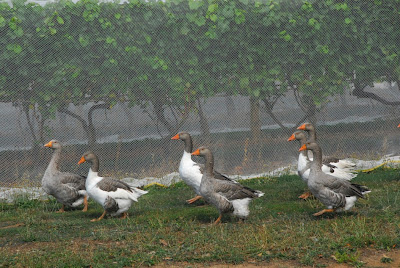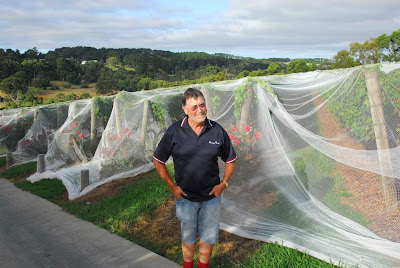After a weekend layover in Melbourne –
great dinner with Mum and brother David at trendy bistro PM24, across the ditch on
Sunday, it was time for a hop skip and a jump around some favourite viticultural
spots in New Zealand.
I had the great privilege of being
chauffeured by one of New Zealand’s leading palates, Raymond Chan.
Perhaps the very first inkling I ever had that a career in wine might even be
possible came when reading my King’s High School yearbook for 1987. Old boy
Raymond’s team had just won the Wilson Neil (?) wine challenge – and early
confirmation of his prowess as a blind taster. Along with Geoff Kelly,
he was later to become a mentor to me as I slowly converted my wine hobby into
a wine habit into a wine obsession. So I was especially glad to have the chance
not only to catch up with an old friend, but to have the benefit of his
comments, questions and insights during our visits for the day.
Martinborough (the heart of the Wairarapa
wine district) is a stomach-churning 40 minute drive out of Wellington, over
the Rimutaka Hills. These form an important divide, a rain shadow flank to a
shallow bowl, noticeably warmer and dryer though just as blustery as the capital
below. The once sleepy little town still felt quiet, but wine regions near
cities – worldwide – provide a local tourism draw, and Martinborough felt a
little more urbane, a little more swish today than I recall ten years ago. The
proximity of the wineries to the little township make it an ideal wine holiday
(take note!), with many located within a long walk, or short bicycle ride of
the boutique hotels and B&Bs which dot the place.
 Two of our visits today would be with
Martinborough classics - Ata Rangi and Dry River (who together with Palliser
Estate, as I recall in the early 1990s, formed what was affectionately known
then as Martinborough’s “Holy Trinity”). But first stop would be with someone
I’d never met and whose wines I’d never tasted, but who I’d read a little about,
and who intrigued me greatly.
Two of our visits today would be with
Martinborough classics - Ata Rangi and Dry River (who together with Palliser
Estate, as I recall in the early 1990s, formed what was affectionately known
then as Martinborough’s “Holy Trinity”). But first stop would be with someone
I’d never met and whose wines I’d never tasted, but who I’d read a little about,
and who intrigued me greatly.
Hiro Kusuda,
does not
fit the normal profile in Martinborough, and not just for the obvious reason
that he is Japanese, though that goes a long way in explaining his aesthetic
preferences, and attention to detail. Japanese traits yes, but it would be easy
to get caught up cliché.
 It’s a classic story of how wine can get
into your veins. From Keio to Fujitsu (read Ivy League to Silicon Valley, or Oxbridge
to City), you might say Kusuda-san was on the gilded track. A switch to work
with Japan’s Foreign Office in Sydney in the ‘90s simply a side-step. But all
the while wine was working its way in. It had been a “passion” as Kusuda-san
put it, since he was eighteen. By 21 he had visited Europe classic sites,
including a pivotal visit to the Mosel and tasting with Egon Müller (III). Meanwhile his brother got involved, importing for a
short time, and translating Robert Parker Jr.’s first edition of Bordeaux into Japanese. “During the
1990s I visited New Zealand four times. Ata Rangi’s 1992 was the first Pinot
Noir outside Burgundy I thought smelled like Burgundy. Then, at a tasting with
Len Evans in Australia I began to think about wine pre-bottling for the first
time. I knew if I chose a career in wine I wouldn’t get bored. It was either an
MW, or become a winemaker.”
It’s a classic story of how wine can get
into your veins. From Keio to Fujitsu (read Ivy League to Silicon Valley, or Oxbridge
to City), you might say Kusuda-san was on the gilded track. A switch to work
with Japan’s Foreign Office in Sydney in the ‘90s simply a side-step. But all
the while wine was working its way in. It had been a “passion” as Kusuda-san
put it, since he was eighteen. By 21 he had visited Europe classic sites,
including a pivotal visit to the Mosel and tasting with Egon Müller (III). Meanwhile his brother got involved, importing for a
short time, and translating Robert Parker Jr.’s first edition of Bordeaux into Japanese. “During the
1990s I visited New Zealand four times. Ata Rangi’s 1992 was the first Pinot
Noir outside Burgundy I thought smelled like Burgundy. Then, at a tasting with
Len Evans in Australia I began to think about wine pre-bottling for the first
time. I knew if I chose a career in wine I wouldn’t get bored. It was either an
MW, or become a winemaker.”
“My English was okay, but when I approached
[Australian and US wine schools] Roseworthy and Davis they wanted $20,000 more
in fees for foreign students. So I went to Geisenheim! First I had to learn to
count - eins zwei drei…!” He finished his 100 page thesis, in German, just a
few days before the birth of his daughter. Hiroic!
After that it seems everything happened
quickly. Work with Kai Schubert at Schubert Wines in
Martinborough during his studies led to the Kusuda family upping sticks and
moving to Martinborough in 2001. By 2002, Kusuda Wines was born and the first
harvest in.
Sitting at Kusuda-san’s dining table, rows
of immaculately polished wine glasses stand at the ready – an appropriate size
and shape for each wine type we are to taste. His fastidiousness is already
becoming quite well known. Some 40 Japanese devotees descend on Martinborough
every year as to assist with his demanding picking and sorting regime. “We
inspect every berry. Anything marked doesn’t go into the wine. I think you can
taste the difference in the grape, so you will taste the difference in the wine.
For example, bunches often have berries that sit up next to the wire and it
marks the skin where there is contact. We remove those.”
On one level this creates an embryo for a
cult wine I think. Those 40 Japanese stagiaires
no doubt make pretty good ambassadors for Kusuda Wines back in Japan. For a
country that values deeply purity and simplicity in aesthetics, it is little
wonder that that market has embraced one of their own to the tune of 70% of
Kusuda sales. The remaining 30% is split evenly between export to Australia and
domestics sales. But I suspect that is more out of deference than necessity.
High ideals are one thing, but the tasting,
for me, demonstrated easily that Kusuda-san’s vision and discipline translate
into some very individual wines of very high quality. We bagan with what would
turn out to be my favourite of the line up –
2011
Kusuda Riesling
10.5%
abv, 7 g/l RS
Very pale gold; gently fragrant, stony
nose, gently honeyed; crisp, fine, some phenolic grip here but this remains
tender, tingly grapefruit expression and acidity, buffered by a fine coating of
honey, long flavoured and very finely textured Riesling. One of the finest
Rieslings I have ever tasted in New Zealand. 93/100
2010
Kusuda Riesling
11.5%
abv, 6 g/l RS
Green gold; fine, quite creamy nose, a
higher level of ripeness than the ’11 perhaps, white flowers; crisp, firm,
grippy middle, broader texture than the ’11, has more weight, but also a touch
of leaness. There is plenty of material here, seemingly in balance but the wine
is closed and difficult to judge. 90+/100?
Kusuda-san
was surprised at this wine’s showing – feeling that it has just now begun to shut
down.
2008
Kusuda Merlot / Cabernet Sauvignon
64%
Merlot and 36% Cabernet Sauvignon. 22 months in French oak barriques, 30$ new.
13% abv. From the vineyard of the now defunct Benfield & Delamare.
Fine clear ruby; fine nose, fresh, piquant,
plummy; fresh, a bit taut, not herbaceous as such, but very high register in
flavor and acidity – tart cranberry amongst the plums and currants. A very
fine, pure elegant texture and style. It will be interesting to see the
aromatics unfurl with a few years in the cellar. 91/100
2010
Kusuda Pinot Noir
A Christmas Eve frost meant 50% of the
potential Te Muna site crop was lost. Some “townside” fruit purchased. 15
months in French oak barriques, 24% new.
Fine hue, mid depth of Pinot colour;
bright, lifted, cool expression of Pinot Noir, raspberry and a touch of plum;
very bright acidity on entry, lovely silky texture and focus, fine intensity,
quite a pure varietal expression of red fruit spectrum flavours. Super
definition. 91/100
2009
Kusuda Syrah
96%
de-stemmed, stainless steel fermentation, 21 month French oak barrique
maturation, 31% new. 14.5% abv
Clear, mid+ ruby; bright, fresh spicy plum
nose, just a touch of sulphur reduction; layered fruit texture, Black Doris
plum, fresh vibrant acidity, mouthfilling and intense but stays lively,
energetic all the way through, moderate weight (no sense of the 14.5% abv),
this has an almost piercing intensity. 90+/100
2006
Kusuda Pinot Noir
95%
de-stemmed, 14 month French oak barrique maturation, 40% new. 14% abv
Fine-hued, mid-depth of colour; lovely pure
red fruit spectrum nose, a little touch of sous bois now; very fine, pure,
elegant on the palate, lovely fruit – a richness of fruit, luminous and intense,
the acidity and fruit pushing to a long fine finish. Enjoyable now, but no
rush. 92/100
Kusuda-san
said he would have picked this a little earlier if made today, to emphasize
tou-mei-kan (see below), but to me, this was in perfect equilibrium, revealing
just what a barbarian I am!
2006
Kusuda Syrah
100%
de-stemmed without crushing, 18 months French oak barriques, 40% new.
Fine clear ruby – still a fresh youthful
appearance; really lovely Syrah nose, blackberry, black pepper, a touch of beef
stock – a very fine, subtly expressed nose; fine, elegant, juicy, lovely
expression of fruit, superb harmony, and a long finish with a crisp cut of acidity.
Exceptional, finely tailored Syrah! 94/100
I think that last ‘finely tailored’ note
for the ’06 Syrah could be used to describe the “Kusuda style”, if something
like that could be deduced from tasting seven wines. There’s no fuzziness of
definition, freshness is emphasized, and with it quite crisp acidity levels
that for some would border the pleasure / pain threshold. But the result is
wines with a translucent clarity of expression. Kusuda-san is aiming for tou-mei-kan (透明感)* as he puts it, a Japanese term meaning in English, in Kusuda-san’s words, “purity
and transparency”. If that is his aim he is achieving it. And what a great addition
to the range of interpretations of grape and soil in New Zealand.
*thanks to my wife Aiko for helping to clarify these, and for the links.
With Hiro Kusuda’s clear bright notes still
resonating in my mind, Raymond and I switched timbres with a visit to
Martinborough classic, Dry River. Planting
began in 1979 at this boutique estate founded by Dawn and Dr Neil McCallum. McCallum,
a Phd graduate in organic chemistry from Oxford University, like Kusuda-san,
had firm ideas and high ideals from the start, and was more interested in
realizing those, than following the winemaking fashions of the day. So while he
became known in part for his benchmark quality Pinot Noirs and Chardonnays, for
me he was the grower that helped turn the light on for aromatic whites from Gewurztraminer,
Pinot Gris and Riesling.
Raymond and I were met by Poppy Hammond,
who has just finished her twelve year tenure here, latterly at the helm, and
has just handed over to former assistant winemaker Wilco Lam. (Dry River sold
in 2002 and the McCallums left in 2011). It was reassuring to see the
fastidiousness, careful empirical approach, and passion still at the heart of
this, the pinnacle of New Zealand wine. It’s an approach aided in part by the
estate’s resistance to expansion – for a reputation so big, this estate remains
astonishingly small – just 2,500 cases in total, from a 10 acres home vineyard,
plus a share of the Craighall Vineyard down the road (shared with Ata Rangi).
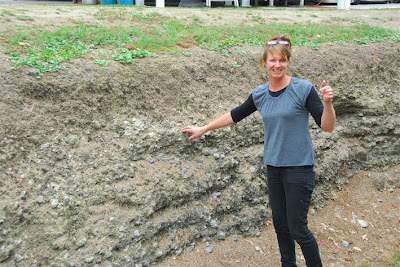 |
| Poppy Hammond shows Martinborough Terrace alluvial soil at Dry River |
Poppy showed us the immaculate vines. Dry
River sits on the Martinborough Terrace, just outside the Martinborough
township, on fairly deep alluvial soils with a thin covering of wind-blown
loess. Roots have been found to at least 6 metres deep (they stopped digging).
“We’re farming phenolics”, said Poppy - a simple, neat statement but an oh so important one as it encapsulates the combined notion of flavour and texture. It's one thing to pick ripe grapes, stick them in a tank and bottle the result. To encourage and retain all that the grape can give in aroma, flavour and texture is entirely another order of effort, skill and good fortune. Dry River are working to that order.
2011
Dry River Riesling
Long
dry autumn, then three instances of rain at harvest. Had to wait and then dry
out. 12% abv, 4.5 g/l RS.
Pale straw; vibrantly aromatic nose, stone
fruit, grapefruit and a touch of honey; fine, racy on the palate, very lime-led
citrus flavor, lovely texture, long grapefruity finish. Complex. 93/100
2009
Dry River Viognier
2006
was the first vintage. 14.13% abv
Pale green gold; a really fresh nose,
honeysuckle; the textured weight and feel of Condrieu here, fragrant, but
subtly so for viognier, very mouth-filling and generous, delicious bittersweet
finish. 91/100
2010
Dry River Pinot Gris
From
32 year old home block vines and 25 year old Craighall vines, Mission clone
which gives really small berries. 13.5% abv, 18g/l RS.
Pale gold; opulent fresh nose of ripe
fragrant pears; juicy sweet pears and spice on the palate, decadently rich vendange tardive opulence to the texture
and tone. Delicious. 92/100
2011
Dry River Gewurztraminer
20
year old vines from the Lovat Vineyard. 14% abv, 20g/l RS.
Light gold; bright spicy varietally
pronounced Gewurztraminer in the high register floral end of the spectrum,
really fresh and inviting; honeysuckle, layered flavour and texture here, lovely
balance and freshness, lushness and weight, spicy, floral, musky finish.
Gorgeous. 92/100
2010
Dry River Pinot Noir
A new
release about to be shown. Actual 12.76% abv (labeled 13% to comply of
course!). Mostly Pommard (UCD 5) clone, with some 10/5 (Swiss), and some Dijon
clones.
Mid+ depth of Pinot colour, fresh
appearance; lovely, quite aromatic, perfumed nose, blue floral edge, dark
cherry core; fine, silky textured, quite concentrated, intense, very fresh,
primary, fine fruit, real persistence on the finish. Super quality. 93+/100
2006
Dry River Pinot Noir
Wet
spring then drought summer. 13.5% abv
Fairly clear, fairly deep shade for Pinot
Noir; vibrant dark cherry and dark plum nose; quite lush and fleshy on the
palate, velvety, seductively-styled. Fine acidity carries the line well though.
Softly sticky fine Pommard-like tannin, though a little silkier – like a very
fine Rugiens perhaps. This is all about generosity and seduction rather than
ethereal grace. Does it well. 92/100
2009
Dry River Lovat Vineyard Syrah
13%
abv
Deep, fairly clear appearance, still some
blue in the colour tone; ripe, quite fragrant nose, dark plum, blackberry, and
with a mineral note in the background; mouthfillingly fresh plummy fruit,
mouthcoating intensity, freshness, real tenderness in the texture, very supple
but present tannins, no sense of heaviness, persistent finish. Will be
interesting to follow in the cellar. 92/100
As expected, this was a line up of superb
quality right across the range and across the vintages sampled. Having followed
these wines since the mid-90s, it was exciting to get beyond the gate and to
see up close and to taste. My advice if you live in the UK, be sure to receive
Justerini & Brooks and/or Raeburn Fine Wine’s offer when these are released. If you are in New Zealand and you aren’t on the
mailing list, what have you been doing!?
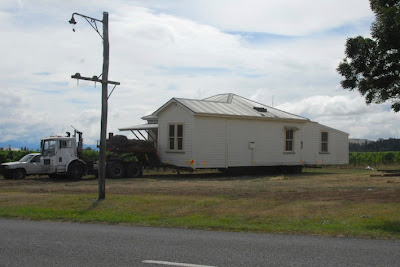 |
| Opposite Dry River: In N.Z. 'moving house' means "drop it off at no.24 please" |
 |
| Cyclists at Vynfields |
Time for a breather, and Raymond and I
settled down to a wonderful vineyard platter of goodies at certified organic
winery Vynfields.
John Bell and Kaye McAuley have an idyllic slice of the Martinborough Terrace
here, which a landmark wooden homestead open as their cellar door and lunch
spot (Raymond and I escaped as the cyclist invasion began). Perhaps it was my
growing hunger, or perhaps it was the use of ISO XL5 tasting glasses (which
were great in their day I suppose, but which are just too small to let the
wines shine), and perhaps any range would have trouble after the peaks
experienced at Dry River, but for me the Vynfield wines were solidly good rather
than standout in quality or style. Vynfield have picked up a string of awards
recently however, so perhaps a re-taste is in order some day. I would certainly
be back for lunch in any case.
 |
| Bottles at cellar door, Ata Rangi |
Re-charged, Raymond and I headed off to our
final appointment for the day at Ata Rangi. This
32 year old estate sits alongside Dry River at the top of the quality stakes in
Martinborough. The ‘mad’ project of former dairy farmer Clive Paton – joined by
sister Ali, and wife Phyll Pattie – Ata Rangi made famous – and in part was
made famous by – a particular clone of Pinot Noir – the Abel, or Gumboot clone.
The full story is here,
but essentially it is believed to be a DRC clone that gives a particular
structure and savouriness to the wine, and characteristic I have long
appreciated here.
Winemaker Helen Masters met us in the
garden terrace between the cellar door and the winery, for an outdoor run
through the range…
2011
Ata Rangi Sauvignon Blanc
Hand
picked from 20 year old blocks.
Light green gold; fresh, fairly creamy
Sauvignon nose; crisp, light, zingy and juicy, this has New Zealand vibrancy
but with creamy-textured interest and a toned-down, more subtle expression.
Very good. 89/100
2011
Ata Rangi ‘Lismore’ vineyard Pinot Gris
Made
since 1998. 20% barrel fermented. 8g/l RS.
Fresh ripe pear with a touch of creaminess
on the nose; juicy on the palate with real mid-palate presence, pear fruit,
generous – indeed there is some warmth of alcohol, but it is in check. Good.
88/100
2010
Ata Rangi ‘Petrie’ vineyard Chardonnay
From
the greater Wairarapa zone, not Martinborough.
Ripe peach, buttered toast nose – if I
hadn’t been told that while this is barrel fermented only 18% of the barrels
are new I would have thought this an overt oak character, but it turns out it
is vineyard specific – some grapefruit notes; ripe, richly textured, candied
lemon, really lively through the richness, creamy long finish. Intensely
flavoured chardonnay. Good. 90/100
2009
Ata Rangi ‘Craighall’ vineyard Chardonnay
100%
Mendoza clone, 27 year old vines.
A fine nose, subdued after the Petrie,
quite mealy in tone; fairly concentrated, creamy-textured, fine, round
mouthfeel, though subdued in expression, still very youthful, soft generous
finish. Good. 90/100
2010
Ata Rangi ‘Craighall’ vineyard Chardonnay
Fine ripe apple nose, a touch of barrel
spice; taut, focused, bright and concentrated chardonnay, this has superb
definition and intensity. Would be my pick over the ’09 for the cellar. 91/100
2011
Ata Rangi ‘Petrie’ vineyard Chardonnay
Tank
sample.
Grapefruit and lemon on the extrovert nose;
rich, intense and juicy, quite fruit-forward in expression. 89-90/100
2008
Ata Rangi ‘McCrone’ vineyard Pinot Noir
A
joint venture with Oegan family the McCrones, planted in 2001 to 40% Abel
clone, 30% Dijon clones and some Pommard (UCD 5) clone. A little more clay in
the soil. 2006 was the first vintage. There was no 2007 due to frost. Waiting
to see if this 2008 is justifiable as a release under its own designated label.
Mid Pinot colour range; bright piquant plum
and cherry nose; there is intensity in the attack, quite spicy plums with a
candied edge, from the mid-palate on the fruit feels quite compote-like, some
warmth on the finish, which I felt lacked a bit in drive. Good. 88/100
2010
Ata Rangi ‘Crimson’ Pinot Noir
Our
earlier drinking label from young vines sites that by nature – more top soil
for example – offer more perfumed fruit, less structure, lovely bright
aromatics and less weight and concentration, explained Helen. The label also
helps support charitable work to promote the conservation of native trees – Rata
and Pohutukawa.
Clear, mid+ depth of fresh youthful colour;
quite ripe and fragrant on the nose; juicy bright red and dark cherry fruit
flavours, quite ripe, decadently styled, bright, fulsome soft Pinot with a
warmish finish. Very nice. 87/100
2010
Ata Rangi Pinot Noir
From
vines aged 32 to 20 years, mostly Abel clone.
Fresh yellow apple and red cherry on the
nose; fine, tautly-structured acids and tannins, very perfumed aromatically
expansive palate, beautifully silky-textured finish. Very fine. 93/100
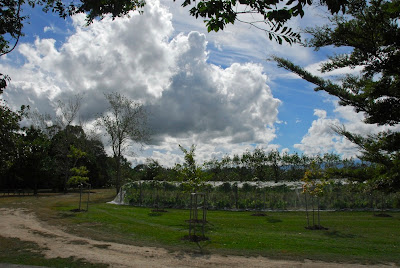 |
| Clouds! Ata Rangi |
This was all a treat enough, and just in
time on this warm afternoon, as my gaze became transfixed by the
extraordinarily puffy billowing clouds looming over the vineyard, Helen ushered
us into the cellar, for a series of barrel tastings which were as fascinating
and educational as I have ever experienced anywhere – it was a masterclass in
Pinot assemblage componentry and one
further – major – lesson, which I will come to.
We began with a barrel sample of 2011 ‘Seriously Nuts’ vineyard (Dijon
clones, making up 25% to 30% of the final blend) – A bit toasty on the nose;
palate shows attractive upfront sweetness, I wrote. Then from a barrel of 2011 ‘Walnut Ridge’ vineyard (22 year
old Pommard – UCD 5 – clone). ‘Not especially fragrant, or sweet, or long!’, I
noted, ‘but interesting mid-palate fruit and texture, and side-of-the-mouth
tannins’. (A small component Helen noted as ‘we cannot get it to do more’).
Next up, from a barrel of 2011 (Abel
clone). ‘Lovely nose, spicy and floral; fine fruit, real depth and length,
though quite elegant.’
At this point I asked if, after 30 years,
Ata Rangi was considering pulling certain blocks or barrels out to make
‘reserve’ or vineyard designate labels. “We’re still finding our way with what
we’ve got – we don’t want to pull it apart. We don’t want these to be marketing
decisions and something we cannot reverse. We want Ata Rangi to be a great
wine, and not pull out a small part to create some cult wine”. Fair play!
 |
| Helen Masters: Ata Rangi assemblage masterclass |
What Helen showed us next was something I’d
not seen before – the impact of early or late malolactic fermentation. We’d
just tried a range of ‘early’ (for “brighter aromatics”), and were now to try
‘late’ (for complexity from greater aldehydes and “more richness and
structure”). First up, a comparative ‘late’ barrel of that 2011 ‘Seriously Nut’s vineyard – ‘denser fruit’ I noted. Then 2011 McCrone Vineyard, 30% whole
bunches, Abel and Dijon 115 clones – ‘spicy fragrant dark cherry; dense
structure and dark fruit expression’. Next, 2011 ‘Lismore’ vineyard
from Swiss clone 10/5 (upright version), 22 year old vines: ‘high note register
fruit, top sweet notes, but lacks grace’.
I felt pretty jubilant after such a
fantastic lesson, and happy to see that Ata Rangi are still making such lovely
wines.
Raymond kindly drove me back over those
gut-wrenching Rimutaka Hills and off to Wellington Airport for a flight to
Christchurch, but with enough time to reflect and discuss the day. I was really
struck by the openness and seemingly unguarded unupholstered way today’s winemakers
shared their thoughts on where things are at. It’s funny how often the
producers who make the very best wines are also so often the most humble,
reflective, inquisitive, and constantly improvement-oriented out there. They’re
good Kiwi traits I’d like to think, and along with good (especially alluvial)
soils, and good winemaking climate, the best asset New Zealand has for
continuing to climb the quality rungs. The Ata Rangi and Dry River visits were
reassuring for that, and the Kusuda visit exciting for the new dimension he is
bringing.
